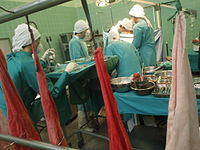
Photo from wikipedia
DOI:10.1097/MOT.0000000000000399 There is no shortage of interesting and/or controversial topics in the field of organ transplantation today that could be timely topics for publication in Current Opinion in Transplantation. The… Click to show full abstract
DOI:10.1097/MOT.0000000000000399 There is no shortage of interesting and/or controversial topics in the field of organ transplantation today that could be timely topics for publication in Current Opinion in Transplantation. The rules by which we allocate or, perhaps more accurately, ration the insufficient supply of organs procured from brain dead and donors after circulatory determination of death (DCDD) and how we arrive at those rules, have plagued the transplant community and the public with controversy since the Organ Procurement and Transplantation Network was established in 1984 and was charged with regulating organ allocation. The allocation algorithms are constantly being reevaluated and in some cases changed in very significant ways based on new data and changes in the field. Although change is difficult and not without controversy and disagreement, it has always been achieved through compromise and consensus building. In 2005, lung allocation changed from a system based on waiting time to a system based on the lung allocation score (LAS) [1]. Additional data variables were added to the LAS score and more diagnoses were added in February 2015. After many years of study and after the rejection of some proposals and compromises on others, a new kidney allocation system was implemented in December 2014 that sought to provide better age matching between donors and recipients, to give higher priority to highly sensitized patients, to provide better access for blood-type B patients and to include dialysis time in a candidate’s waiting time [2]. Major changes in heart allocation occurred in 2006 to allow for greater regional sharing based on clinical urgency. Further modifications will be implemented in 2017 that propose to better stratify transplant candidates, to better adjust to the more frequent use of mechanical circulatory support devices and to reduce geographic differences in access to donor hearts [3]. There was not unanimous agreement for these proposals, but they were ultimately passed by a majority of the United Network for Organ Sharing (UNOS) 11 regions and the UNOS Board of Directors. Proposed changes in liver allocation, however, have been very contentious and polarizing. In this issue, proponents of a new redistricting plan that aims to reduce the variability in Model for End-stage
Journal Title: Current Opinion in Organ Transplantation
Year Published: 2017
Link to full text (if available)
Share on Social Media: Sign Up to like & get
recommendations!